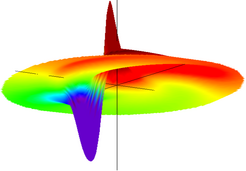A quick switch for magnetic needles
Magnetic vortex cores, which can be used as particularly stable storage points for data bits, can now be switched much faster
Microscopically tiny ferromagnetic platelets exhibit a phenomenon which could be exploited in the future for particularly stable magnetic data storage: so-called magnetic vortex cores. These are needle-shaped magnetic structures measuring 20 nanometres (millionths of a millimetre) in diameter. Five years ago, researchers at the Max Planck Institute for Intelligent Systems (formerly the Max Planck Institute for Metals Research) in Stuttgart found a way to reverse the magnetic field needles despite their stability using only a tiny amount of energy so that their tips pointed in the opposite direction. Such a switching process is necessary to enable the vortex cores to be used in data processing. The Stuttgart scientists have now discovered a new mechanism which makes this switching process at least 20 times faster and confines it to a far smaller region than before. Magnetic vortex cores could thus provide a means of data storage which is stable, fast and greatly miniaturized.

An edge length of a mere thousandth of a millimetre and a thickness of a few millionths of a millimetre: these are the tiny dimensions of the platelets which the researchers in Hermann Stoll’s group at the Max Planck Institute for Intelligent Systems in Stuttgart are investigating. They are made from Permalloy, an alloy of nickel and iron, and their shape ensures the formation of an ordered magnetic structure. The arrangement resembles a shooting target: like tiny compass needles the magnetic moments of the atoms in the plane of the platelet form concentric circles, so-called vortices.
This circular arrangement changes in the centre of the platelet. “Imagine you were to form concentric circles using matches,” explains Hermann Stoll. “You cannot do this in the centre of the circle because the matchsticks are too long. You then have to turn them out of the plane so that they form a needle which stands perpendicular to the plane”. Something similar happens in the vortex platelets: a kind of magnetic field needle forms, which juts out of the plane, the so-called vortex core, with a diameter of a mere 20 nanometres. Since it can point either upwards or downwards, it can be used to store bits of information.
The polarity of the vortex core can be switched by means of a magnetic field acting from the outside; this field must be very strong, however, around half a Tesla. This roughly corresponds to one third of the field that the strongest permanent magnet can supply. It has the advantage that magnetic storage of this type would be stable against interfering magnetic fields. This stability also turns into a disadvantage, however, because it makes it more difficult to reverse the vortex core and thus process data.
